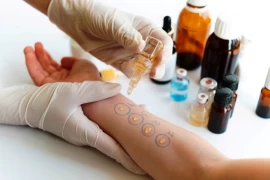
Could My Child Have a Food Allergy?
- Could My Child Have a Food Allergy?
Food allergies have become one of the important health problems of today and their frequency is increasing. Food allergy can manifest itself in different ways. In some babies, gas pains, bloating, mucous (slimy) or bloody stools, resistant frequently recurring rash or diarrhea, vomiting may occur, while in some babies, skin rashes may occur as allergic eczema (atopic dermatitis). In older children, hives (urticaria) and edema (swelling) are more prominent.
While normal delivery, breastfeeding, providing a healthy and balanced diet can be protective in reducing the possibility of food allergy, especially feeding with additives poses a risk. Today, alienation from a healthy natural life seems to be evident with an increase in food allergies.
Food allergies can occur in different ways. Therefore, not every diagnostic method is valid for every patient. While allergy testing is very valuable in some patients, it does not help us in some patients. This distinction can only be made by the physician. Therefore, starting food diets with the family's own decision may cause unhealthy results and adversely affect the health of the baby and the mother.
Finding the responsible food and removing it from the diet is the most important step in the treatment of food allergy. Correct adjustment of diets and prevention of unnecessary food restrictions are very important for a healthy course of growth and development. It should be known that calcium and vitamin D supplements should be given to breastfeeding mothers, especially those whose diets include milk and dairy products.
The most important diagnostic step in any food allergy is to take a good family history. Questioning the food-complaint relationship is gold. Food allergy tests can be done from blood and skin to babies and children of any age. Skin tests are painless, fast and reliable, giving results in 15 minutes. It would be appropriate for the allergist to evaluate in which patient group the test is required in infants with suspected food allergy. Removing the food from the diet with the test result is not sufficient alone in the treatment. At the same time, the family should talk about how to replace the food that seems responsible in the test, and when and how diet expansions should be planned.
Anaphylaxis (Allergic Shock) is a very important life-threatening allergic condition in children and the most common cause in children is food allergies. Recognizing this group of patients, evaluating them in terms of risk, prescribing an adrenaline autoinjector (in case of emergency, a ready-made needle to be applied by the families at home in case of emergency) and informing the family are of life-saving importance. Another important point is school-age children with ongoing food allergies. Since the child's self-expression and protection may be insufficient, especially in the preschool age group, at the age of nursery and kindergarten, everyone from school personnel to service personnel should be knowledgeable about food allergies and have the competence to use adrenaline autoinjectors.
It should be kept in mind that food allergies should not be interpreted as just a physical disease and that it is a process that wears out both the child and the family psychologically. It is very important to ensure their sociality safely in environments rich in different foods such as birthday events, domestic goods week. While such problems can be experienced in younger age groups, peer bullying in adolescents or brave behaviors such as "if I eat it, nothing will happen" can have very negative consequences.
There is another important point to be noted. In people with severe food allergies, any product that has come into contact with that food may also have serious consequences. For example, an allergic reaction may occur if a nut eater kisses a child with a nut allergy. Let's give another example; Even if a person with an egg allergy buys eggless bread from a bakery that has previously made egg pita, there is a possibility of an allergic reaction. Even minimal contact can be life-threatening, especially for people with a history of anaphylaxis or severe food allergies.
It is very important to be careful and conscious in this regard, as early and correct diagnosis and rapid treatment of children with food allergies are an important part of healthy growth and development.





